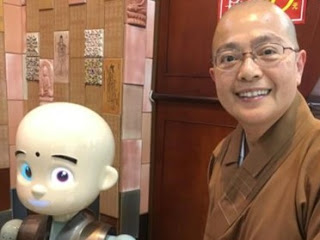
Speaker: Venerable Jue Ji
Director of Xiang Yun Temple, Austin, Texas, U.S.A
Have you noticed that at the back of the Mountain Gate of Fo Guang Shan Monastery, there are four Chinese characters, which reads huí tóu shì àn (回頭是岸), meaning “Turn Around to Salvation”.

When visitors are about to leave the temple, upon seeing the words, they will contemplate the meaning of it and hopefully they will turn around to cultivate a land of real peace.
At Xiang Yun Temple where I serve now, there is also the same wording depicted on the back of the Mountain Gate. What a thoughtful design that people can review the Buddha’s teaching before they leave the temple. Can “turn around” be the way to salvation? This is so contradictory to the logic way of doing things. We are educated to move forward to obtain what we want. Turn around can be a sign of weakness, cowardice, irresponsibility, and so on. But here “Turn Around” is a pause in our fast spinning daily life schedule so that we can retrospect on things we have done, contemplate on thoughts arisen in our mind, people that we have come across. That “Turn Around” provides us conditions to advance our spiritual cultivation and eventually free us from suffering.
The worldly affairs outside the temple are full of anxieties, worries, uncertainties, competitions, schemes, etc. To “Turn Around” means to turn away from all these negative things and thoughts. Our mind needs to go to a quiet spot to meditate. The temple is one of that quiet spots. We can find any available quiet spots to meditate. It is said that when the mind stops wondering, the world is quiet and peaceful. We need to remind ourselves to pause, turn around, and then we can recharge, refresh, and become rejuvenated.
There is a poem written by a Buddhist monk, Budai, in Tang Dynasty, around the 10th century. The poem is entitled, On Enlightenment. The first session of the poem reads:
With my hands, I plant a field full of rice seedlings,
As I lower my head, I discover a sky in the water;
To purify the six sensory roots is truly the Way,
A step backward is actually a step forward.
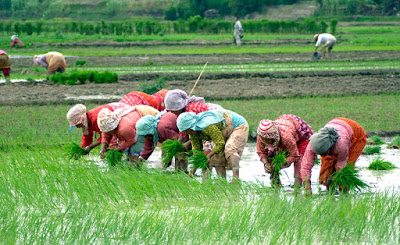
The poet made use of the metaphor of a farmer planting rice seedlings to vividly present the way of spiritual cultivation. It is human tendency to see what we have at the present moment and look forward to what we are going to obtain in the future. But the Buddhist way to look at the timeline of our life is: no beginning in the past, no ending in the future. Life is an ongoing continuum, all the past and all the future are connected to who I am NOW. Stepping backward needs not to mean a concession or recession due to failure or lacking of ability to accomplish a task. On the contrary, it can be a strong move to transform ourselves and a step further to liberation of suffering.
We are like a farmer planting Bodhi seeds in our mind. We should humble ourselves, not only by physically lowering our head, but also mentally bowing to all people. This is the way to see our Buddhahood, the goal which is as high as the sky. However, that “sky” is not high above us, instead that sky is under our feet. We step on our goal while at the same time we cultivate ourselves to obtain the goal. Oftentimes we misunderstand that we should move forward to catch our goal, not knowing that the Buddhahood has never been far away from us. We just need to humble ourselves, look inward to our mind, the goal is right there inside our mind. We have been too proud of our being a human being, that we have a big “I” that occupy our mind. We need to purify our body, speech, and mind in order to walk on the Way. The six sensory roots are our body and mind. We need to do good deeds, say good words, and think good thoughts to put our body-and-mind in the process of purification. This is truly the Way.
Living in a life of a beginningless past and the endless future, we will find that the discussion of stepping forward or backward would undoubtedly lead to a meaningless empty talk. We shall not feel embarrassed to step backward when everyone else is moving forward. Backward and forward become a worldly dichotomous concept that Buddhist should detach from. It is absolutely natural and human that we choose to step backwards sometimes.
Take this COVID-19 pandemic for example. Due to the “stay-at-home” order, we are restricted from doing shopping, dining outside, hugging people, shaking hands with friends, gathering in parties, etc. Life seemingly went back to the pre-hi-tech era when mass communication systems and social media were not yet introduced to the world. In those days, people enjoyed simple things in life. Family members spend more time at home, people do more handcraft stuff, and parents need to be more creative in handling both parenting duties and work from home. Obviously COVID-19 pandemic has changed our life, both positively and negatively.

To look things at the bright side, COVID-19 pandemic has pushed us to learn to deal with ourselves. The restricted schedule of going outward has pressed us to seek something DO-able to within a limited space. And this is the secret ingredient of meditation. A limited space could “harness” our mind more efficiently. We have more time to see ourselves inwardly. For many people, the world is at home now.
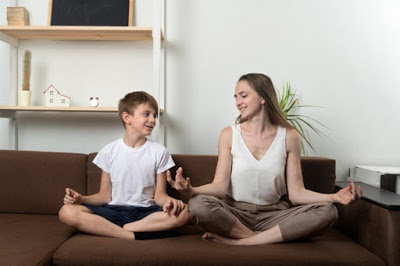
Comparing with the life before COVID-19, our life now is “turning around”, taking a step back and confronting the “I” that constantly wants to move out and step forward.
Here are the action plan for you in practicing “turn around”.
First, to calm the mind
We need to calm our mind first. If our mind is like a mirror, we need to clean the “mirror” to see things as they really are. If it is hard to have few moments of calmness, then try to see ourselves from a third person’s perspective.

Or imagine that we are an island in the ocean. The seashore is our mind. When we breathe in, thoughts arise in our mind, like sea waves brushing onto the sea shore. When we breathe out, thoughts fade away from our mind, like sea waves recede to the ocean. The sea shore is then revealed. Sea waves come and go, just like our thoughts arise and fade away. In our breathing in and out, we let the thoughts of sea waves come and go. Living, working, and studying in a limited space at home, we really need to calm down the mind first.
Second, to appreciate
COVID-19 has taught us to turn around and appreciate what we have had right here-and-now.
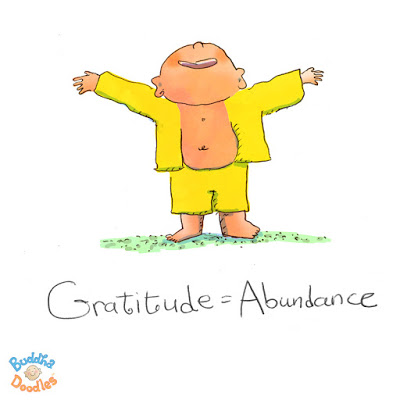
What is the best thing to do when we have to spend most of our time at home? Be appreciative. Having worked hard on every step we have made, it is rewarding to step backwards and silently observe what we have done from a third person’s perspective. Being appreciative itself is rewarding.
Third, to progress
A good example is Venerable Master Hsing Yun’s retiring from his abbotship in 1985. He was just 58 years old then! This is too young for a promising capable monk to claim his retirement. But for Venerable Master Hsing Yun, this is like welcoming a new life in a rebirth.
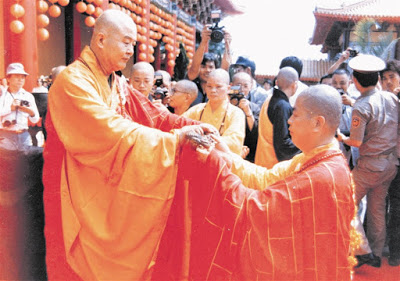
Empty handed, Venerable Master Hsing Yun went to Kaohsiung to establish Fo Guang Shan. Empty handed, he retired from the abbotship of Fo Guang Shan. Come and go, he was not attached to anything. Thus come, thus gone. Nothing is different. Again and again, we hear the founder of Fo Guang Shan monastery say that Fo Guang Shan does not belong to him; instead, he emphasizes that Fo Guang Shan belongs to everyone. Why did Venerable Master Hsing Yun choose to retire his abbotship in the highlight of his days? He gave the following four reasons in the ceremony of abbotship handover ceremony:
1. System management is better than human management. People come and go, experiencing the process of birth, aging, sickness, and death. For an organization to last long, it should implement system management, not human management.
2. Worldly affairs need not be accomplished by one single person. Everyone can contribute to the efforts of propagating Buddha Dharma and purifying the human mind in society.
3. Retiring from the position of abbotship does not mean retiring from work. After retiring from abbotship of Fo Guang Shan, there is more work to do in propagating Buddha Dharma, serving the society, and liberating all beings from suffering.
4. Administering the alternation of abbotship in order to handover leadership from the senior to the junior. The handover of abbotship proves the excellence of the new generation.
In other words, Venerable Master Hsing Yun “turns around” in the highlight of his days to focus his mind on a greater scope of propagating Buddha Dharma in the world. He paused and looked at the footprints that he had gone through in promoting Humanistic Buddhism. The retiring from his abbotship has enabled him to accomplish more in spreading the seed of Buddha Dharma worldwide. Like the poem of the Monk Budai, when Venerable Master Hsing Yun lowers his head, he discovers a sky in the water. Take a step back; Venerable Master Hsing Yun has contributed more to the propagation of Buddha Dharma.
This is why the Mountain Gate of a Buddhist temple inscribes huí tóu shì àn (回頭是岸), Turn Around to Salvation. A pause to turn around would lead to appreciate people and things that contributed to our growth in life, which further inspires us to grow and progress. Let’s plant a Bodhi seed in our mind. Let’s humble ourselves to progress. Let’s purify our deeds, speech, and thought. We will discover the “sky” in where we stand. The salvation is not far ahead; it resides in the turn around.

